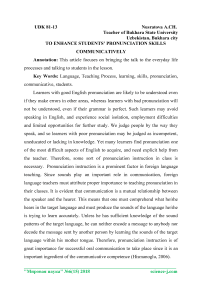To enhance students’ pronunciation skills communicatively
Автор: Nusratova A.Ch.
Журнал: Мировая наука @science-j
Рубрика: Основной раздел
Статья в выпуске: 6 (15), 2018 года.
Бесплатный доступ
This article focuses on bringing the talk to the everyday life processes and talking to students in the lesson.
Language, teaching process, learning, skills, pronunciation, communicative, students
Короткий адрес: https://sciup.org/140263692
IDR: 140263692
Текст научной статьи To enhance students’ pronunciation skills communicatively
Learners with good English pronunciation are likely to be understood even if they make errors in other areas, whereas learners with bad pronunciation will not be understood, even if their grammar is perfect. Such learners may avoid speaking in English, and experience social isolation, employment difficulties and limited opportunities for further study. We judge people by the way they speak, and so learners with poor pronunciation may be judged as incompetent, uneducated or lacking in knowledge. Yet many learners find pronunciation one of the most difficult aspects of English to acquire, and need explicit help from the teacher. Therefore, some sort of pronunciation instruction in class is necessary. Pronunciation instruction is a prominent factor in foreign language teaching. Since sounds play an important role in communication, foreign language teachers must attribute proper importance to teaching pronunciation in their classes. It is evident that communication is a mutual relationship between the speaker and the hearer. This means that one must comprehend what he/she hears in the target language and must produce the sounds of the language he/she is trying to learn accurately. Unless he has sufficient knowledge of the sound patterns of the target language, he can neither encode a message to anybody nor decode the message sent by another person by learning the sounds of the target language within his mother tongue. Therefore, pronunciation instruction is of great importance for successful oral communication to take place since it is an important ingredient of the communicative competence (Hismanoglu, 2006).
Pronunciation is a set of habits of producing sounds. The habit of producing a sound is acquired by repeating it over and over again and by being corrected when it is pronounced wrongly. Learning to pronounce a second language means building up new pronunciation habits and overcoming the bias of the first language (Cook, 1996). Pronunciation refers to the production of sounds that we use to make meaning. It includes attention to the particular sounds of a language (segments), aspects of speech beyond the level of the individual sound, such as intonation, phrasing, stress, timing, rhythm (suprasegmental aspects), how the voice is projected (voice quality) and, in its broadest definition, attention to gestures and expressions that are closely related to the way we speak a language.
Pronunciation aspects. Vowels and Consonants
First of all there are the sounds. These are of two types, vowels and consonants. Vowels and consonants perform different functions in their syllable. Each syllable has a vowel at its centre and the consanants “surround” the vowel, preceding it and cutting it off. Sometimes two consanants occur in the end of the word and it is called a consonant cluster.
Word stress. When an English word has more than one syllable, one of these is made to stand out more than the others. This is done by saying that syllable slightly louder, holding the vowel a little longer, and pronuncing the consonants very clearly. These features combine to give that syllable prominence or stress.
Rhythm. Englis speech resembles music in that has a beat. These are groups of syllables, just like bars of music and within each group there are strong and weaker beats. There is a tendency in English for the strong beats to fall on nouns, verbs, adjectives and adverbs ( words that carry a loy of meaning) and for the weak beats to fall on preposition, articles and pronounce (words with a grammatical function).
Intonation. Speech is also like music in that it uses changes in pitch, speakers can change the pitch of their voice as they speak making it higher or lower in pitch at will. They can jump up suddenly in pitch as singers do. So speech has melody called intonation. The two basic melodies are rising and falling. These can be very sudden, or gradual, and it can be put together in various combinations. Speakers use pitch to send various messages. Sentence stress and intonation work together to help speaker and the precise message they want to send (Joanne Kenworthy, Teaching English Pronunciation, 1988).
Over the years, styles of language teaching have changed greatly, and the same is true of teaching pronunciation. Until recently, the focus in pronunciation teaching was almost entirely on producing individual sounds and words correctly; not much attention was given to features such as intonation and rhythm. In the last 20 years or so, however, teachers and researchers have begun to realize the importance of these “musical” aspects of pronunciation and to emphasize them more strongly in teaching. Some scholars have gone so far as to claim that teaching individual sounds is not so important, and intonation, stress, prominence, and rhythm should be emphasized above all.
Список литературы To enhance students’ pronunciation skills communicatively
- Barrera Pardo, D. (2004) "Can pronunciation be taught? A review of research and implications for teaching", Revista Alicantina de Estudios Ingleses 17: 31-44.
- Bowen, T.- marks, J. (1992) The Pronunciation Book: Student-Centered Activities for Pronunciation Work. London: Longman.
- Haycraft, B. (1971) The Teaching of Pronunciation. A Classroom guide. London: Longman.
- Maccarthy, P. (1972) Talking of Speaking. Papers in Applied Phonetics. London: Oxford University Press (Language and Language Learning).


